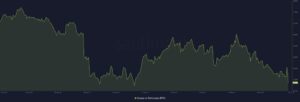The dollar strength index (DXY) has crossed 110 for the first time since 2002, and is just 10 away from an all time high since 1984.
For much of its rise however, a rule of sorts developed whereby if gas and oil drop, the dollar drops. That rule, at least for the day, seems to be broken.
Gas fell further on Wednesday to below $8, with European gas on Dutch futures down as well about 10% to €225.
In a new development, oil has plunged, falling 4%. WTI crude, for the US markets, is close to falling into the $70s, finally some would say.
One key reason is China. Based on overall data it appears very likely their economy has locked a contraction for this quarter, Q3 2022, with their banks reporting a 50% increase in delays or defaults by the property sector.
Newly released data further shows their oil imports have decreased by 10% over last year for August, while gas imports are down 15%, with some Chinese media putting gas imports down 25% over last year.
A price cap on gas and oil prices by the EU, which seemingly responds to the cartel that includes Russia with a cartel of its own, will further increase downwards pressure on commodity prices, and that may lower inflation too.
On that front, the European Central Bank is set to increase interest rates by 0.50%. They need to get to 2%, though gradually, as the European economy overall grew 4% in Q2 2022.
The third quarter should be excellent for at least some of Europe as well as ‘oppressed’ tourism demand came back with some vengeance this year to pay off two years of cordoned traveling.
To keep that going, arguably you need to give banks some incentives to lend, and so the rise in interest rates may be short term monetary tightening by the public sector, but may translate into loosening by the commercial banking sector.
US is already above 2% however, but Fed will keep raising interest rates, though logically a further hike of 0.75% should be off the table at this point.
Even a raise of 0.5% may be too much at this stage as it wouldn’t be too clear just what theoretical basis they would rely on now that rates are above 2%.
The US economy needs to be able to handle 2% rates however if we’re to see proper growth, with one interesting question being why is DXY rising when commodities priced in it, and thus a significant part of the dollar demand, are falling.
The reason may be because capital is moving from China to US. China now faces a real threat of potential stagnation, for a decade or two, as political interference in enterprise and innovation, in addition to their credit cards being maxed out, may be putting some sort of a ceiling on growth.
US and Europe in contrast have been developing numerous innovative industrial technologies over the past two decades, with Europe in particular having considerable room for growth as their decades of investment in the eastern half lower the burden moving forward.
In addition, there’s the peace dividend of course where our own soldiers are concerned. That’s mostly sentimental and probably does matter in overall measures of things like productivity, with the war in Ukraine kind of isolated and perhaps at a turning point now that they’re making advancements.
So capital from emerging markets is headed to US, with Chinese media keen to criticize the dollar ‘hegemony’ from which they have benefited for decades as that ‘hegemony’ gave higher returns in China than US, until now.
And we put hegemony in singular quotes because the euro is now a significant player, but the euro is not yet at 2% returns, so apparently it is not attracting as much capital as US, at least for now.
A weak euro is a boon to exporting economies anyway, which used to include Italy until they sent even their $300 luxury Versace flip flops to China. Imagine buying bragging rights Italian ‘high’ fashion with Made in China when 90% of the price is for the Made in Italy part.
Italy does produce plenty of things however, still, as does Germany and France of course, and so provided the energy part is solved, the euro weakness can translate into growth.
Yet attracting some of the fleeing capital should set better foundations for growth, and so these DXY levels may be artificial and temporary, primarily due to the Fed moving first and way too fast at a significant expense for their economy which is back to the sclerotic growth of 1.6% for Q2 annualized, or just 0.4%.
This artificiality however has some basis due to Fed moving fast, while one theory regarding bitcoin’s recent price move might be more fundamental artificiality.
That’s because it maybe fell just because DXY rose, something that in theory shouldn’t affect bitcoin because the value of the dollar is relative to other national fiat, and so if DXY rising means there’s lower or higher demand for BTC in US, it should mean the opposite in Europe, so cancelling out.
You can argue adoption in US is more advanced, but it may well be also the case that immature and unsophisticated bots are too narrow in perspective, something that presumably will be addressed in due course through euro related arbitrage and hedging strategies.
There’s also the view among some traders that euro stocks don’t matter for bitcoin, while US stocks do. There can be some basis to that as there are more crypto related business and mining stocks in US, but not to the point where euro stocks can be ignored completely.
One significant difference however between US and euro where the crypto market is concerned, is that the dollar does have a dominant stablecoin, while the euro stablecoin almost doesn’t exist at all, with its influence comparable to CNY in global finance. Basically, not there.
This dollar stable, which is an integral part of the crypto market, may give the dollar more influence than the euro, and by proxy their stocks too.
The strengthening of the dollar overnight however might be more some sort of a blip, or even confusion, as speculators try and make sense.
Because with gas and oil now falling, the dollar strength should start falling too, and investment assets should start stabilizing as the UK at least seems to have found the solution in the government just covering the costs of energy, which should erase a lot of inflation, while EU too seems to be drawing a blueprint for a solution, which may well work.
And thus we may well be at least at the beginning of the end of this energy crisis, with so much doom in corporate media perhaps suggesting the doom has peaked.
People won’t freeze this winter, that’s just Putin’s deluded fantasy. Businesses won’t go bankrupt either as the media loves to panically yell, and the rise in interest rates is actually a good thing because they are rising due to the economy growing on the fast lane, at least up to Q2.
The panic in stocks therefore may be unwarranted too, with the months long transition period now seemingly largely over, and so hopefully we’re moving towards some stabilization in western markets as autumn arrives.
A good sign of that may be these glitches where market pairs seemingly move in a strange way, but of course we’ll have to wait and see whether we are actually at least starting to get out of the woods after the great dive of 2022.
- Bitcoin
- blockchain
- blockchain compliance
- blockchain conference
- coinbase
- coingenius
- Consensus
- crypto conference
- crypto mining
- cryptocurrency
- decentralized
- DeFi
- Digital Assets
- ethereum
- featured
- machine learning
- Markets
- news
- non fungible token
- plato
- plato ai
- Plato Data Intelligence
- Platoblockchain
- PlatoData
- platogaming
- Polygon
- proof of stake
- Trustnodes
- W3
- zephyrnet













